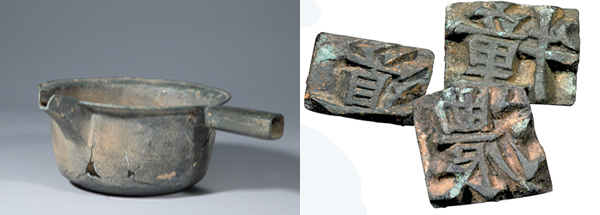Discovery questions origin of metal types

Movable metal types and a bronze kettle, left, that are believed to be from as early as 1239. Provided by the museum
Koreans have long believed that Jikji Simche Yojeol was the proof of the world’s oldest movable metal types. Jikji is a book that contains the essentials of Zen Buddhism and was printed at the Heungdeok Temple in Cheongju, North Chungcheong, using movable metal types in July 1377. It is on Unesco’s Memory of the World Register.
Last week, the Daboseong Ancient Art Museum - which is run by Kim Jong-chun, the chairman of the Korea Ancient Art Association - revealed nine movable metal types along with the bronze kettle and bronze container that they discovered alongside.
The kettle and the container also had a movable metal type stuck on the surface - one in each - according to an X-ray scan. So all together, that makes 11 movable metal types.
The museum alleges that the 11 types are at least 138 years older than Jikji, quoting the results of research done by scholars in various fields. One result was a radiocarbon dating by a group of researchers at Seoul National University. It found that the types were made between 1185 and 1300. Another radiocarbon dating by the Korea Institute of Geoscience and Mineral Resources supports this theory.
Experts of the Goryeo Dynasty (918-1392) - an era the relics came from - also supported the museum’s argument. Lee Seung-cheol, a researcher at the Cheongju Early Printing Museum, says “there were government bodies dedicated to creating and preserving metal types. The kettle and the container help us imagine the work done at such organizations.”
Lee Oh-hee, the honorary chairman of the Korean Society of Conservation Science for Cultural Heritage, also said that “the bronze kettle and container take the shape and style of Goryeo-era items. And the way it’s rusted in different parts is also a typical form seen in bronze relics buried for a long time.”
In fact, Jeungdogaja was first introduced to the Korean academia in 2010. Nam Kwon-hee, professor of library and information science at Kyungpook National University, claimed that the metal types are “believed to have been made in the 13th century” and that it matches the font style and size of the 1239 book on Buddhist realization.
Nam’s theory, however, was deemed unlikely by most Korean historians.
But in ensuing years, research was done on the relics, and this led the Daboseong Ancient Art Museum to invite journalists last week to give the glimpse into the relics.
“I plan to present Jeungdogaja at the meeting of Association of European Printing Museums in September as well as upcoming academic conferences in the U.S. and Tokyo,” Nam said.
Before Park Byeong-seon (1929-2011), a renowned librarian and historian, found Jikji in 1972 at the National Library of France, the international community believed the 42-line Gutenberg Bible (printed in 1455) was the first book printed using movable types. Besides Jikji, some earlier metal type printings are mentioned in the old Korean historical documents.
BY KIM HYUNG-EUN [hkim@joongang.co.kr]










with the Korea JoongAng Daily
To write comments, please log in to one of the accounts.
Standards Board Policy (0/250자)